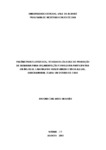Please use this identifier to cite or link to this item:
http://www.alice.cnptia.embrapa.br/alice/handle/doc/997273| Title: | Parâmetros florísticos, fitossociológicos e de produção de biomassa para orçamentação forrageira participativa em áreas de caatinga no Assentamento Vista Alegre, Quixeramobim, Ceará: um estudo de caso. |
| Authors: | MOURÃO, A. E. B.  |
| Affiliation: | Antonio Édie Brito Mourão. |
| Date Issued: | 2013 |
| Citation: | 2013. |
| Description: | Resumo: A Caatinga é um dos biomas brasileiros menos conhecidos botanicamente. Sua vegetação é uma das principais fontes alimentares para herbívoros domésticos. Com o objetivo de comparar os aspectos florísticos, fitossociológicos e de biomassa em áreas sumetidas à diferentes manejos, foram selecionadas três áreas que receberam como manejo o raleamento com fins pastoris (CRI); raleamento para fins apícolas (CRII) e Caatinga nativa não manipulada (CN). Inicialmente foi elaborado um inventário botânico e determinados seus aspectos fitossiológicos de densidade e cobertura e trimestralmente a produção de biomassa durante um ano. A análise dos resultados demonstraram que Euphorbiaceae foi a família botânica mais abundante com 1.918,75 indivíduos/ha correspondendo a 66,16% do total amostrado. Em menor número, Combretaceae, Caesalppiniacea, Brassicaceae e Malvaceae representaram 1,08% dos indivíduos. Croton sonderianus Muell. Arg. Foi a espécie mais encontrada (63,15%), seguida de Mimosa caesalpiniifolia Benth (11,42%) e Cordia oncocalyx Allemão (10,34%). Estas espécies são predominantes em outras regiões semiáridas. CR I apresentou com nove espécies mostrou diversidade semelhante a CN com onze espécies. Mimosaceae, Fabaceae e Boraginaceae foram comuns nas três áreas, enquanto a Malvaceae ocorreu apenas em Caatinga raleada I. Combretaceae e Brassicaceae ocorreram apenas na Caatinga nativa. As áreas manejadas apresentaram uma densidade total de 318,75 indivíduos/ha (CR I) e 450 indivíduos/ha (CRII). A Caatinga nativa apresentou 100% de cobertura específica arbóreo-arbustiva, enquanto a Caatinga raleada I apresentou 22,3% e a Caatinga raleada II apresentou 27,2%. A produção anual de litter em Caatinga nativa (CN) foi de 18.227,43 Kg/ha, significativamente superior a caatinga raleada I (CRI) (12.382,69 Kg/ha ano-1) e caatinga raleada II (CRII) (11.059,89 Kg/ha ano-1), sendo que as duas últimas não diferiram entre si. A miscelânea foi a fração mais representativa em todas as áreas, correspondendo a 48,88% (6.052,67 Kg/ha ano-1) do litter produzido na área de Caatinga raleada I, 44,08% (4.874,80 Kg/ha ano-1) em Caatinga raleada II sendo estas semelhantes entre estatisticamente entre si e 54,33% (9.903,6 Kg/ha ano-1). Conclui-se que a práticas de manipulação da Caatinga podem manter a biodiversidade vegetal apesar de alterar os aspectos estruturais. [Floristic and phytosociological parameters and biomass production of forage participatory budgeting in the Caatinga]. Abstracts: The Caatinga is one of the least known botanically biomes. Its vegetation is one of the main food sources for domestic herbivores. In order to compare aspects floristic and phytosociological biomass in areas sumetidas to management, were selected as three areas that received the sleaze management purposes pastoris (CRI); thinning purposes bee (CRII) and Caatinga native unmanipulated ( CN). Initially we designed a botanical inventory and certain aspects fitossiológicos density and coverage and quarterly biomass production for a year. The results showed that botanical family Euphorbiaceae was the most abundant 1918.75 with individuals / ha corresponding to 66.16% of total samples. Outnumbered, Combretaceae, Caesalppiniacea, Brassicaceae and Malvaceae represented 1.08% of individuals. Croton sonderianus Muell. Arg. Was the species most commonly found (63.15%), followed by Mimosa caesalpiniifolia Benth (11.42%) and Cordia oncocalyx Allemão (10.34%). These species are prevalent in other semiarid regions. CR I presented with nine species showed similar diversity CN with eleven species. Mimosaceae, Fabaceae and Boraginaceae were common in all three areas, while the Malvaceae occurred only in Caatinga thinned I. Combretaceae and Brassicaceae occurred only in native Caatinga. The managed areas had a total density of 318.75 individuals / ha (CR I) and 450 individuals / ha (CRII). The Caatinga native had 100% coverage of specific trees and shrubs, while the Caatinga I thinned caatinga showed 22.3% and 27.2% had thinned II. The annual production of litter in Caatinga native (CN) was 18227.43 kg / ha, significantly exceeding thinned caatinga I (CRI) (12382.69 kg / ha yr-1) and thinned caatinga II (CRII) (11,059, 89 kg / ha yr-1), with the latter two did not differ. The smorgasbord was the most representative fraction in all areas, corresponding to 48.88% (6052.67 kg / ha yr-1) of litter produced in the area of Caatinga I thinned, 44.08% (4874.80 kg / ha yr-1) in Caatinga thinned II and these statistically similar between each other and 54.33% (9903.6 kg / ha yr-1). It is concluded that the Caatinga handling practices can maintain plant diversity in spite of the structural change. |
| Thesagro: | Caatinga Vegetação Biomassa Pastagem nativa Manejo Raleio Cobertura do solo |
| NAL Thesaurus: | Botanical composition Semiarid zones Vegetation Biomass Land cover Brazil |
| Keywords: | Semiárido Floristic composition Raleamento Brasil Região Nordeste Ceará Grassland Management |
| Notes: | Dissertação (Mestrado em Zootecnia) - Universidade Estadual Vale do Acaraú, Sobral. Orientador: Roberto Cláudio Fernandes Franco Pompeu (CNPC). |
| Type of Material: | Teses |
| Access: | openAccess |
| Appears in Collections: | Tese/dissertação (CNPC)  |
Files in This Item:
| File | Description | Size | Format | |
|---|---|---|---|---|
| UPAParametros.pdf | 8,07 MB | Adobe PDF |  View/Open |









